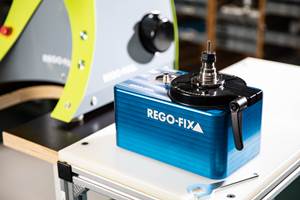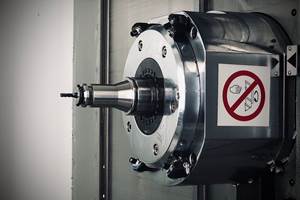Why Lifting Magnets Are Attractive
Compared to slings and chains, they save time and protect the part. Here are some of the basics of magnetic lifters.
Share




Magnetic lifters are versatile work handling devices that can be used to move a variety of ferrous metals ranging from small bundles of rod or scrap to large, heavy blocks. When used to replace slings and chains, lifting magnets can improve overall productivity by allowing a single person to lift a load that may have required two or more people the old way. The trick is to move the load safely, and to do that the equipment needs to be properly specified and applied.
Magnetic lifters offer advantages related to both quality and labor. For example, magnets eliminate the need for drilling and tapping holes in parts so that eyebolts can be attached to move them. In many cases, these holes need to be filled and the surface needs to be refinished, adding cost to the product.
An example of how a magnetic lift can positively impact productivity might involve a crate of parts that require machining. Often the parts are situated in such a package side by side, to use all of the area in the container. If the parts are located so that the operator can only access the parts from above, a lifting magnet can be applied to a single part, lifting it vertically out of the container.
Assuming the container is filled with round shafts packaged horizontally, using a strap or chain in place of a magnetic lifter would require one end of the part to be lifted manually so that the strap or chain could be passed underneath—just to lift a single bar. A lifting magnet could be lowered from the crane above, attached to the desired piece and lifted out of the container with minimal effort.
Magnets further save time by eliminating blocking and slinging. They also reduce waste. Because magnets won't mar metal surfaces, they decrease the potential for the kind of product damage often caused by chains, hooks and other mechanical grabs.
Types Of Lifting Magnets
There are two basic types of lifting magnets: permanent magnets and electromagnets.
Permanent magnets are exactly that—permanent. These magnets use permanently magnetized material to build up the magnetic field.
Permanent magnets used in work sites generally turn on and off by means of a lever. They can be used to handle flat materials, as well as round parts weighing up to 2,200 pounds. These kinds of lifters are self-contained and can be moved without difficulty to various work sites within machine shops. However, one disadvantage is that permanent magnets have a restricted lifting capacity.
Electromagnets employ electricity to charge the magnet and hold the material to the magnet face. Electromagnets use an energized electrical coil wrapped around a steel core to orient particles within ferrous materials in a common direction, thus creating a magnetic field. Electromagnets are generally built to run on DC current, creating the need for a rectifier. Unlike permanent magnets, electromagnets require a constant power source. This can be viewed as either a detriment or an advantage, depending upon how the magnet is being used. A power failure can be catastrophic when using an electromagnet—though universal power supplies and battery backup systems available in today's market address these concerns. On the other hand, the ability to vary the current being supplied to the magnet allows the user more flexibility than a permanent magnet affords.
Permanent Vs. Electromagnets
Both permanent magnets and electromagnets can be constructed to produce different types of magnetic fields. The first consideration in choosing a magnetic circuit is the job you want the magnet to do. Permanent magnets are favored when electricity is not readily available, when power failures are a common occurrence or when adjustable magnetic force is not necessary. Electromagnets are useful for applications where varying strength is required or remote controlling is desired. Magnets should be used only in the manner for which they were originally intended. Using the wrong type of magnet for a specific application can be extremely dangerous and possibly even deadly.
Many machining operations are performed on thick, block-shaped material. These applications call for permanent magnets. Many machine shop users believe the greatest advantage of these magnets is the lack of an electrical hookup or a recharging requirement.
Permanent magnets feature capacities ranging from 330 pounds to 10,000 pounds. These magnets are easily turned on and off by simply rotating a lever. A safety latch is typically built in to ensure that the magnet is not accidentally turned off while performing a lift. Multiple magnets can be used for heavier loads that are too long for a single unit to handle.
Still, there are times when the part to be machined is thin—0.25 inch or thinner—and the part is presented to the machine operator as one of a stack of similar parts. Permanent magnets are not designed to lift only one piece from the stack at a time. Permanent magnets, while extremely reliable when properly applied, are not able to alter the amount of magnetism produced. In this case, an electromagnet with variable voltage control allows the operator to manage the magnetic strength and select only one piece from the stack.
Self-contained electromagnets are the most cost-effective magnets per pound of lift. Capacities can extend up to 10,500 pounds. Reducing costs of equipment and operation, self-contained electromagnets operate on 115-volt AC power.
Battery-powered magnets are available. They use a self-contained gel cell-type battery to expand the lifting capacity, and they allow handling of flat products, rounds and structural shapes. Battery-powered magnets can be moved from hoist to hoist, offering generous lifting capacity without an external power connection. They do require periodic recharging.
Getting Started With Magnetic Lifters
Lifting magnets, whether electric or permanent, all have a rated capacity listed on the nameplate. This capacity relates to a particular thickness. If the magnet is being used on a material that is thinner than the material it was rated on, the capacity will be reduced. Lifting magnets may be used in multiples on beams to augment the amount capable of being lifted. When multiple magnets are used to lift loads, the magnets should be spaced evenly to carry the whole load. Materials have a tendency to sag when unsupported, so magnets should be sized properly to support the load. When loads are being lifted and rotated to a shear position, it should be noted that the magnet's capacity drops to about one-fourth of what the nameplate states. Additionally, materials tend to slide when subjected to shear forces. Therefore, much care should be taken in these applications.
Larger magnets present on overhead cranes are dedicated to the crane mechanism and its range of movement. Multiple magnet mounts give overhead cranes a lifting capacity limited only by the crane itself. The fundamental components of these systems include the magnet or magnets suspended from the crane hook(s), and a spread beam if necessary.
Given that magnets operate on DC, a combination AC to DC rectifier and magnet controller is mounted on the crane. This device converts the crane power from AC to DC and turns the magnet on and off.
Remotely operated lifting magnets can be cab controlled, or they can be controlled through a pendant switch or a remote control transmitter. These systems are used to deal with single or multiple plate, whether in storage areas, loading or unloading of trucks, or loading and unloading of cutting tables.
A trained professional must install the magnet. The supplier will usually send out personnel to evaluate the application and handle the installation process. Electromagnets require greater setup time and additional equipment because of the DC electrical connection. Electromagnets are also outfitted with battery backups in case of power failure.
Related Content
Quick-Change Tool Heads Reduce Setup on Swiss-Type Turning Centers
This new quick-change tooling system enables shops to get more production from their Swiss turning centers through reduced tool setup time and matches the performance of a solid tool.
Read MoreHow to Mitigate Chatter to Boost Machining Rates
There are usually better solutions to chatter than just reducing the feed rate. Through vibration analysis, the chatter problem can be solved, enabling much higher metal removal rates, better quality and longer tool life.
Read MoreFive Common Mistakes Shops Make with ER Collets (And How to Prevent Them)
Collets play a crucial role in the machining process, so proper tool assembly and maintenance is important. Here are five potential pitfalls to avoid when using ER collets.
Read MoreHow to Troubleshoot Issues With Tool Life
Diagnosing when a tool is failing is important because it sets an expectation and a benchmark for improvements. Finding out why gives us a clue for how to fix it.
Read MoreRead Next
Setting Up the Building Blocks for a Digital Factory
Woodward Inc. spent over a year developing an API to connect machines to its digital factory. Caron Engineering’s MiConnect has cut most of this process while also granting the shop greater access to machine information.
Read MoreRegistration Now Open for the Precision Machining Technology Show (PMTS) 2025
The precision machining industry’s premier event returns to Cleveland, OH, April 1-3.
Read MoreBuilding Out a Foundation for Student Machinists
Autodesk and Haas have teamed up to produce an introductory course for students that covers the basics of CAD, CAM and CNC while providing them with a portfolio part.
Read More

















.jpg;maxWidth=300;quality=90)












